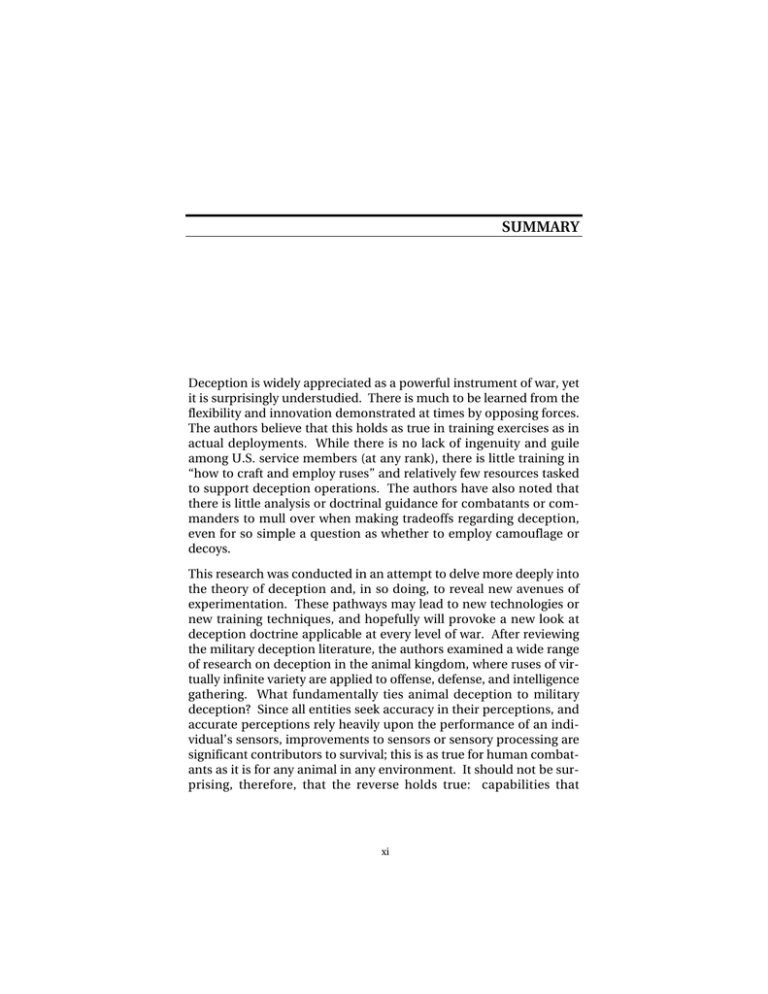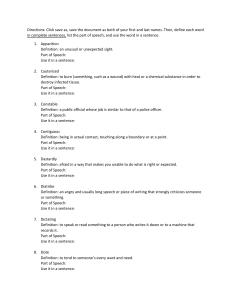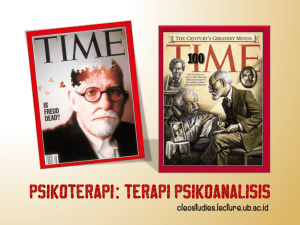SUMMARY
advertisement

SUMMARY Deception is widely appreciated as a powerful instrument of war, yet it is surprisingly understudied. There is much to be learned from the flexibility and innovation demonstrated at times by opposing forces. The authors believe that this holds as true in training exercises as in actual deployments. While there is no lack of ingenuity and guile among U.S. service members (at any rank), there is little training in “how to craft and employ ruses” and relatively few resources tasked to support deception operations. The authors have also noted that there is little analysis or doctrinal guidance for combatants or commanders to mull over when making tradeoffs regarding deception, even for so simple a question as whether to employ camouflage or decoys. This research was conducted in an attempt to delve more deeply into the theory of deception and, in so doing, to reveal new avenues of experimentation. These pathways may lead to new technologies or new training techniques, and hopefully will provoke a new look at deception doctrine applicable at every level of war. After reviewing the military deception literature, the authors examined a wide range of research on deception in the animal kingdom, where ruses of virtually infinite variety are applied to offense, defense, and intelligence gathering. What fundamentally ties animal deception to military deception? Since all entities seek accuracy in their perceptions, and accurate perceptions rely heavily upon the performance of an individual’s sensors, improvements to sensors or sensory processing are significant contributors to survival; this is as true for human combatants as it is for any animal in any environment. It should not be surprising, therefore, that the reverse holds true: capabilities that xi xii Unweaving the Web: Deception and Adaptation in Future Urban Operations engender inaccuracy in the perceptions of the foe (be it attacker or defender) tend to be highly advantageous. This capability is defined as deception, and the advantage it provides stems from the erroneous action that so often follows an inaccurate perception. Although the literature on deception in animal biology has only recently emerged from naturalism and become an experimental science, it is richer and more scientifically rigorous than the corresponding literature on military deception. This should not be taken as a criticism of the quality of work on military deception, but rather a comment on its nature: there is relatively little scientific literature on military deception. What experimental work exists is often narrowly focused, and the remainder of the literature is made up of informed opinion and illustrative anecdote. In light of this, the authors have sought to mine animal biology for suggestive lessons and experimental hypotheses on deception and counterdeception. The authors found this enterprise to be of value in several respects: Deception can be of immense value. The unforgiving nature of natural selection, combined with a truly staggering prevalence of deception, strongly supports the argument that causing an adversary’s perceptions to be inaccurate (i.e., degrading their situational awareness) is of enormous value in virtually any setting or type of conflict. As an adaptation, deception techniques are as important as improvements to speed, armor, and weapons; why, then, does the U.S. military accord deception such little actual importance? What can be done to change this, and what can be gained thereby? More emphasis and tighter integration of deception in tactics, techniques, and procedures (TTPs) into operations and technological development would clearly be of benefit, particularly in a world of asymmetrically minded opponents. Deception is a complex phenomenon that requires a nuanced analytic approach. There are many deceptive methods that may accomplish similar ends, and the details of the deceptions matter greatly. Some deceptions rely mainly on the physical realm, while others emphasize the behavioral realm. Some deceptions are fixed and unchanging, while others show great flexibility and may even be tailored to particular opponents. The authors have identified at least three axes along which to measure individual deceptions, and at least three means by which individual deceptions may be aggregated. Summary xiii When faced with an individual deception, the warfighter or analyst can usefully distinguish between different levels of sophistication (static, dynamic, adaptive, premeditative); different effects sought (masking, misleading, confusing); and different means of deception (morphological, behavioral). Moreover, deceptions in practice are often aggregations of individual deceptions, and such aggregation can be across physical space and time, or can be synergistic combinations of individual methods. The authors found the complexities and nuances of animal deception a rich source of material in developing deception theory for both prescriptive and proscriptive ends. Moreover, this material proved to be a wellspring of numerous questions that must be asked about military deception, and it suggests experiments that may answer them with an ultimate aim of improved cost/benefit analysis of deception. As noted in their previous work (Gerwehr and Glenn, 2000), the authors have found that synergy arises when deception is conducted in urban terrain. The characteristics of urban environments—the density of structures, the teeming population, the complexity of terrain, the multiplicity of channels for communication, the voluminous background “noise,” the prodigious quantity and heterogeneity of resources—allow for a great diversity and enhanced effectiveness of deception measures. The vast majority of deceptions practiced in the animal kingdom have valuable analogs in urban terrain. The authors believe that from animals there are useful insights to be gained about all military deception in all environments, yet the benefits to urban operations will be greatest. The term “adaptation” is often used when describing the learning and innovation of combatants in military conflicts, particularly in urban operations. Many of these adaptations involve improvements to deception methods, that is, means for degrading or manipulating an adversary’s situational awareness. Not surprisingly, this type of adaptation is tremendously commonplace and valuable in animal biology. An observer can begin to characterize combatants along a spectrum of adaptability, a descriptor we call the adaptive index. Further, an analysis of this type has a prescriptive role quite apart from its descriptive one. As we consider why combatants innovate, the rate at which such innovation occurs, and with what means innovation is institutionalized, a doctrine for countering adversary adaptation begins to emerge. The authors believe that this type of xiv Unweaving the Web: Deception and Adaptation in Future Urban Operations guidance is especially needed in urban operations, where the qualities and pace of adversary adaptation have significant, even decisive, consequences. Moreover, the authors believe that U.S. forces may want to consider instituting means (in both training and technology) that encourage adaptations (devolved to the company, platoon, or squad levels) as a counterweight to those of the adversary. Having studied deception at some length, the authors believe that although counterdeception is an important component of reconnaissance and surveillance (R&S), the two concepts are not equal. Counterdeception is a skill set of its own that requires conscious allocation of resources and training. The authors identified at least five distinct categories of counterdeception (focusing upon data type, data collection, data analysis, unmasking deception with deception, and rendering deception moot). We hypothesize that the most effective approaches to penetrating deception entail (1) combining more than one category of counterdeception and (2) applying the right category of counterdeception. Intelligence analysts receive counterdeception training as a distinct element in their curriculum. Given the prevalence and diversity of deceptions encountered by friendly forces in urban operations, training in counterdeception and improved counterdeception TTPs would prove quite valuable. Adaptation features prominently in operations in urban terrain that occur or unfold over time and with multiple engagements. U.S. forces ought to explicitly aim to interfere with or manage adversary adaptation. Among the greatest benefits of a counteradaptive approach is in the area of counterdeception. Those adaptations that interfere with an opponent’s reconnaissance and situational awareness—that is, deceptions—improve one’s own survivability at the expense of the opponent. Built-up terrain supports and promotes these types of adaptations greatly. Thus, hindering an adversary’s adaptation is likely to reduce the quantity and quality of deceptions that he is able to field, adding value to one’s own reconnaissance efforts (and thus to every action that requires situational awareness). The authors believe that just as experiments in encouraging/ improving friendly adaptation ought to be run, so should experiments and exercises in which an explicit aim of the friendly force is to hinder or otherwise manage adversary adaptation. This would be the biological equivalent of choosing from an array of selective pres- Summary xv sures to apply to one’s competitors, instead of simply leaving the choice up to chance and nature. Lessons learned on the friendly actions that are the most effective in shaping adversary adaptation would be invaluable, particularly in stability and support operations (SASO) occurring over time in urban terrain. A better understanding of deception carries important technological implications. As plans are drawn up for the technologies that will undergird the Interim Brigade Combat Team and Objective Force, improvements in the science of deception should figure prominently in these designs. Given the enhanced survivability of organisms that employ well-tailored deceptions, it would appear that investment in deception science is extremely worthwhile.







